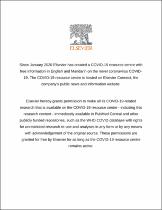| dc.description.abstract | Background: The pandemic and its related social restrictions have led to many uncertainties in nurse education,
including the fear of infection in clinical learning settings and the challenge of remote learning. The modification
of clinical and academic environments generated anxiety and academic concerns among nursing students.
Objectives: To explore the main determinants of anxiety related to the clinical and classroom environments in
nurse education after the second wave of the COVID-19 Pandemic.
Design: Multicentre cross-sectional study.
Settings: Ten universities offering nursing bachelor programs in central and southern Italy.
Participants: A convenience sample of 842 nursing students.
Methods: From April to July 2021, the Self-Rating Anxiety Scale and the Altered Student Study Environment Tool
were administered to assess, respectively, students’ anxiety and their concerns about the study environment. A
regression model was tested.
Results: Most of the nursing students were female (76.6 %), living with family (70.9 %), and full-time students
(85.7 %); 44.6 % were third-year of Bachelor in Nursing students. The majority of the participants (88.5 %)
showed a level of anxiety. The statistically significant predictors of anxiety levels were concerns about grade
attainment (β=0.42, p < 0.001) in the total sample, and, among the first-year students, the completion of clinical
placement (β=0.14, p = 0.047).
Conclusions: Results suggest a need for the redesign of teaching activities and clinical learning experiences to
ensure academic outcomes and to preserve students’ psychological well-being. Models of learning environments’
dynamic adaptation and ongoing psychological support should be implemented to develop tailored
interventions. | en_US |

